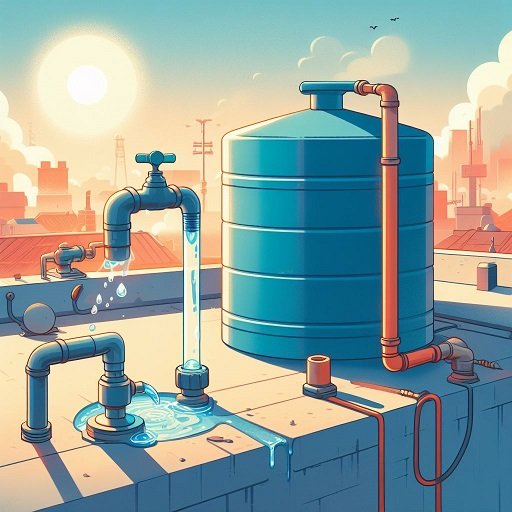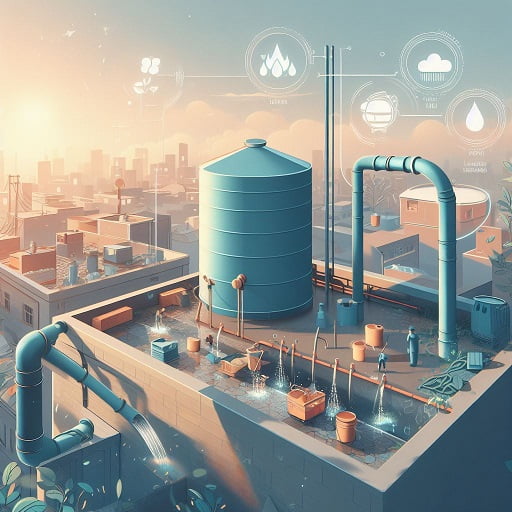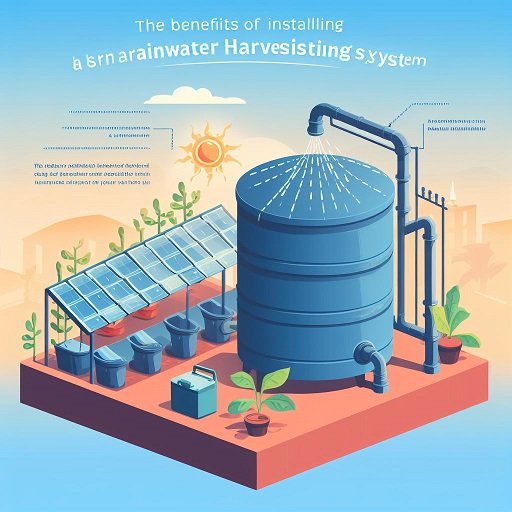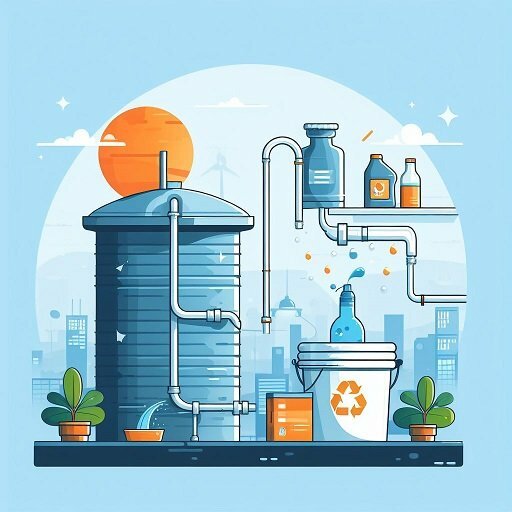Karachi is the largest and most populous city in Pakistan, with an estimated population of over 20 million people. It is also the economic, cultural, and political hub of the country, contributing to about 25% of its GDP. Karachi is located on the coast of the Arabian Sea, and has a hot and humid climate, with an average annual temperature of 26°C and an average annual rainfall of 250 mm.
Water tanks are an essential part of Karachi’s water supply system, as they store and distribute water to various sectors of the city, such as residential, commercial, industrial, and municipal. Water tanks can be classified into two types: ground-level tanks and overhead tanks. Ground-level tanks are usually large and cylindrical and are placed on the ground or underground. Overhead tanks are smaller and spherical and are mounted on rooftops or towers. Both types of tanks are connected to pipelines that deliver water to different areas.
Climate change is a global phenomenon that affects the environment and human activities in various ways. Climate change refers to the long-term changes in the average weather patterns of a region or the planet, such as temperature, precipitation, wind, and sea level. Climate change can have significant impacts on water resources, as it can alter the availability, quality, and demand of water.
The purpose of this article is to examine the impact of climate change on water tanks in Karachi and to explore the consequences for water supply and the possible mitigation and adaptation strategies. This article will also present some case studies of real-life examples and success stories in dealing with climate challenges.
Climate Change in Karachi
Karachi is one of the most vulnerable cities in the world to climate change, as it faces multiple climate-related challenges, such as heat waves, floods, droughts, cyclones, sea level rise, and salinity intrusion. These challenges pose serious threats to the city’s infrastructure, economy, health, and social well-being.
According to the Pakistan Meteorological Department (PMD), Karachi has experienced significant changes in its climate over the past decades. The PMD has reported that Karachi’s average annual temperature has increased by 1.5°C since 1960, and that the city has witnessed more frequent and intense heat waves in recent years. For instance, in 2015, Karachi suffered from a deadly heat wave that killed over 1,200 people and hospitalized thousands more.
The PMD has also observed that Karachi’s average annual rainfall has decreased by 10% since 1960, and that the city has faced more erratic and extreme rainfall events. For example, in 2020, Karachi received a record-breaking rainfall of 484 mm in August alone, which was more than double the normal amount for the entire monsoon season. The heavy rainfall caused widespread flooding and damage to homes, roads, bridges, power lines, and water tanks.
The PMD has further noted that Karachi’s sea level has risen by about 10 cm since 1950, and that the city is exposed to more frequent and severe cyclones from the Arabian Sea. For instance, in 1999, Cyclone 02A hit Karachi with winds of up to 150 km/h and a storm surge of up to 3 m. The cyclone caused extensive coastal erosion and inundation of low-lying areas.
The historical climate data for Karachi from 1960 to 2020 are summarized in Table 1 below.
| Climate Variable | Change | Trend |
| Average Annual Temperature | +1.5°C | Increasing |
| Average Annual Rainfall | -10% | Decreasing |
| Sea Level | +10 cm | Rising |
Table 1: Historical Climate Data for Karachi from 1960 to 2020 [Source: PMD]
Water Tanks in Karachi
Water tanks play a vital role in providing water to Karachi’s population, as they store and distribute water from various sources. The main sources of water for Karachi are the Indus River Basin (IRB), which supplies about 80% of the city’s water demand; local groundwater aquifers (LGA), which supply about 15% of the city’s water demand; and rainwater harvesting (RWH), which supplies about 5% of the city’s water demand.
The IRB water is transported to Karachi through three major canal systems: the Kalri Baghar Feeder (KBF), which carries about 650 million gallons per day (MGD); the Kinjhar Lake Feeder (KLF), which carries about 100 MGD; and the Hub Dam Feeder (HDF), which carries about 100 MGD. The IRB water is treated at four major water treatment plants: the Pipri Water Treatment Plant (PWTP), which has a capacity of 520 MGD; the Gharo Water Treatment Plant (GWTP), which has a capacity of 100 MGD; the Hub Water Treatment Plant (HWTP), which has a capacity of 100 MGD; and the North East Karachi Water Treatment Plant (NEKWTP), which has a capacity of 100 MGD. The treated water is then stored in ground-level tanks and overhead tanks, and distributed to different zones of the city through pipelines.
The LGA water is extracted from shallow and deep wells, boreholes, and tube wells, which are mostly owned and operated by private individuals or companies. The LGA water is usually untreated and of poor quality, and is mainly used for non-potable purposes, such as washing, cleaning, and gardening. The LGA water is also stored in ground-level tanks and overhead tanks, and distributed to different areas of the city through pipelines or tankers.
The RWH water is collected from rooftops, terraces, courtyards, and other impervious surfaces, and is stored in ground-level tanks or overhead tanks. The RWH water is usually untreated and of variable quality, and is mainly used for potable purposes, such as drinking, cooking, and bathing. The RWH water is also distributed to different parts of the city through pipelines or tankers.
The total number of water tanks in Karachi is estimated to be around 200,000, with a combined storage capacity of about 2 billion gallons. The distribution and usage of water tanks vary according to the location, income level, and water availability of the users. Generally, the users in the central and eastern zones of the city have more access to IRB water and rely less on LGA water and RWH water; while the users in the western and northern zones of the city have less access to IRB water and rely more on LGA water and RWH water.
Water tanks are vulnerable to climate change, as they can be affected by changes in precipitation patterns, rising temperatures and evaporation, and salinity intrusion. These factors can have negative impacts on the quantity and quality of water stored in the tanks, as well as on the structure and function of the tanks.
Impact of Climate Change on Water Tanks
Changes in Precipitation Patterns
Climate change can alter the precipitation patterns in Karachi, resulting in more frequent and intense floods and droughts. These extremes can have adverse effects on water tanks in different ways.
Increased Flooding Risk
Heavy rainfall can cause flooding in Karachi, which can damage or destroy water tanks. Flooding can also contaminate water tanks with pollutants, pathogens, debris, and sediments. Moreover, flooding can disrupt the water supply system by damaging pipelines, pumps, valves, meters, and other components. Flooding can also increase the demand for water for emergency relief and recovery purposes.
Decreased Rainfall
Low rainfall can cause droughts in Karachi, which can reduce the availability of water for storage in water tanks. Droughts can also affect the quality of water stored in water tanks by increasing the concentration of contaminants, such as salts, metals, nitrates, pesticides, and bacteria. Furthermore, droughts can affect the water supply system by reducing the pressure and flow of water in pipelines. Droughts can also increase the demand for water for domestic and agricultural uses.
Rising Temperatures and Evaporation
Climate change can increase the temperatures in Karachi, which can increase the evaporation rate of water from water tanks. Evaporation can reduce the quantity of water stored in water tanks by lowering the water level. Evaporation can also affect the quality of water stored in water tanks by increasing the salinity and turbidity of water. Additionally, evaporation can affect the structure and function of water tanks by causing thermal expansion and contraction of materials.
Salinity Intrusion
Climate change can cause sea level rise in Karachi, which can increase the salinity intrusion into groundwater aquifers. Salinity intrusion can affect the quantity and quality of groundwater available for storage in water tanks by reducing the freshwater yield and increasing the salt content. Salinity intrusion can also affect the structure and function of water tanks by corroding metal parts and clogging pipes.
Consequences for Water Supply
The impact of climate change on water tanks can have serious consequences for water supply in Karachi. These consequences include:
Drinking Water Quality
The deterioration of water quality in water tanks due to climate change can pose health risks to users who consume untreated or poorly treated water. Water contamination can cause various diseases, such as diarrhea, cholera, typhoid, hepatitis A, dysentery, giardiasis, and cryptosporidiosis. These diseases can affect the physical and mental health of users by causing dehydration, malnutrition, weakness, fatigue, depression, and anxiety. These diseases can also increase the mortality and morbidity rates of users, especially among children, elderly, and immunocompromised people.
According to the World Health Organization (WHO), Pakistan ranks among the top 10 countries with the highest burden of diarrheal diseases, which are mainly caused by unsafe drinking water. The WHO estimates that about 53,000 children under the age of five die every year from diarrheal diseases in Pakistan. The WHO also reports that about 40% of the population in Pakistan lacks access to improved drinking water sources, and that about 90% of the drinking water samples in Karachi are contaminated with fecal coliform bacteria.
The quality of water stored in water tanks can be affected by various factors, such as the source of water, the type of tank, the duration of storage, the exposure to sunlight and heat, the presence of animals and insects, and the maintenance and hygiene practices. The quality of water stored in water tanks can be measured by various parameters, such as pH, turbidity, color, odor, taste, temperature, dissolved oxygen, total dissolved solids, hardness, alkalinity, chloride, nitrate, sulfate, fluoride, arsenic, iron, manganese, lead, copper, zinc, cadmium, mercury, and coliform bacteria.
The quality of water stored in water tanks can be improved by various methods, such as boiling, chlorination, filtration, solar disinfection, ultraviolet disinfection, reverse osmosis, distillation, and ion exchange. These methods can reduce or eliminate the contaminants and pathogens in water, and make it safe and suitable for drinking. However, these methods can also have some limitations or drawbacks, such as cost, availability, accessibility, maintenance, efficiency, and environmental impact.
The quality of water stored in water tanks can also be monitored and regulated by various standards and guidelines, such as the Pakistan Standards and Quality Control Authority (PSQCA), the WHO Guidelines for Drinking-water Quality, and the National Environmental Quality Standards (NEQS). These standards and guidelines can provide the acceptable limits and criteria for the various parameters of water quality, and ensure the compliance and accountability of the water suppliers and users. However, these standards and guidelines can also face some challenges or barriers, such as lack of awareness, enforcement, testing, reporting, and coordination.
Water Supply and Demand
The reduction of water quantity in water tanks due to climate change can affect the water supply and demand balance in Karachi. According to the Karachi Water and Sewerage Board (KWSB), the current water demand in Karachi is about 1,200 MGD, while the current water supply is about 650 MGD, resulting in a water deficit of about 550 MGD. The water deficit is expected to increase in the future due to population growth, urbanization, industrialization, and climate change. The water deficit can lead to water shortages, rationing, conflicts, and social unrest.
Health Implications
The impact of climate change on water tanks can have negative implications for the health and well-being of users. As mentioned earlier, water contamination can cause various diseases, such as diarrhea, cholera, typhoid, hepatitis A, dysentery, giardiasis, and cryptosporidiosis. These diseases can affect the physical and mental health of users by causing dehydration, malnutrition, weakness, fatigue, depression, and anxiety. These diseases can also increase the mortality and morbidity rates of users, especially among children, elderly, and immunocompromised people.
Mitigation and Adaptation Strategies
The impact of climate change on water tanks can be mitigated and adapted by implementing various strategies at different levels. These strategies include:
Infrastructure Upgrades
The infrastructure of water tanks and the water supply system can be upgraded to enhance their resilience and efficiency. For example, water tanks can be repaired or replaced with more durable and leak-proof materials; pipelines can be insulated or buried to reduce heat loss and evaporation; pumps can be powered by renewable energy sources to reduce greenhouse gas emissions; valves and meters can be automated to regulate water pressure and flow; and sensors and alarms can be installed to monitor water level and quality.
Rainwater Harvesting
Rainwater harvesting can be promoted as an alternative or supplementary source of water for storage in water tanks. Rainwater harvesting can reduce the dependence on IRB water and LGA water, which are vulnerable to climate change. Rainwater harvesting can also improve the quality of water stored in water tanks by reducing the salinity and turbidity of water. Rainwater harvesting can be implemented at different scales, such as household, community, or institutional levels.
Community Awareness Programs
Community awareness programs can be conducted to educate and empower users about the impact of climate change on water tanks and the importance of water conservation and management. Community awareness programs can also encourage users to adopt best practices for using and maintaining water tanks, such as cleaning and disinfecting tanks regularly; covering tanks with lids or nets to prevent contamination; checking tanks for leaks or cracks; using filters or purifiers to treat water; and reusing or recycling water for non-potable purposes.
Government Initiatives
Government initiatives can be taken to support and facilitate the mitigation and adaptation strategies for water tanks. Government initiatives can include developing and implementing policies and regulations for water tank standards, quality, and safety; providing subsidies or incentives for water tank installation, maintenance, or improvement; enforcing laws or penalties for water tank misuse or abuse; establishing or strengthening institutions or agencies for water tank management; and collaborating or coordinating with other stakeholders or sectors for integrated water resources management.
Case Studies
To illustrate the impact of climate change on water tanks and the mitigation and adaptation strategies in practice, here are some case studies of real-life examples and success stories from Karachi:
Real-life Examples of Climate Impact
- In August 2020, Karachi experienced a record-breaking rainfall of 484 mm in one month, which caused severe flooding in many parts of the city. The flooding damaged or destroyed thousands of water tanks, especially overhead tanks that were exposed to strong winds and rain. The flooding also contaminated many water tanks with sewage, garbage, chemicals, and animal carcasses. The flooding disrupted the water supply system by breaking pipelines, pumps, valves, meters, and other components. The flooding also increased the demand for water for relief and recovery purposes, such as cleaning, washing, and drinking.
- In June 2015, Karachi suffered from a deadly heat wave that killed over 1,200 people and hospitalized thousands more. The heat wave increased the temperature in Karachi to over 40°C, which increased the evaporation rate of water from water tanks. The evaporation reduced the quantity of water stored in water tanks by lowering the water level. The evaporation also increased the salinity and turbidity of water stored in water tanks by concentrating the contaminants. The heat wave also affected the structure and function of water tanks by causing thermal expansion and contraction of materials, which resulted in cracks, leaks, or bursts.
Success Stories in Mitigation
- In 2018, the Karachi Water Partnership (KWP), a non-governmental organization, launched a project called “Water Conservation through Rainwater Harvesting” in collaboration with the KWSB and the Sindh Environmental Protection Agency (SEPA). The project aimed to promote rainwater harvesting as a sustainable and climate-resilient source of water for storage in water tanks. The project installed rainwater harvesting systems in 50 schools and 50 mosques in Karachi, which benefited about 100,000 people. The project also conducted awareness campaigns and training workshops for students, teachers, religious leaders, and community members on the benefits and practices of rainwater harvesting.
- In 2019, the KWSB initiated a project called “Water Tank Rehabilitation Program” with the support of the World Bank and the Asian Development Bank. The project aimed to improve the quality and quantity of water stored in water tanks by repairing or replacing damaged or outdated tanks. The project also aimed to improve the efficiency and reliability of the water supply system by installing automated valves and meters, sensors and alarms, and renewable energy sources. The project targeted about 10,000 water tanks in Karachi, which served about 5 million people.
Lessons Learned
The case studies of climate impact and mitigation reveal some important lessons learned for dealing with climate challenges for water tanks in Karachi. These lessons include:
- Climate change is a reality that cannot be ignored or denied. It is essential to monitor and assess the climate trends and projections for Karachi, and to plan and prepare for the potential impacts on water tanks and other water resources.
- Climate change is a complex and multidimensional problem that requires a holistic and integrated approach. It is necessary to consider the interrelationships and interdependencies among water tanks and other components of the water supply system, such as sources, treatment plants, pipelines, pumps, valves, meters, etc.
- Climate change is a shared responsibility that demands a collaborative effort. It is important to engage and involve all stakeholders and sectors in the mitigation and adaptation strategies for water tanks, such as government agencies, non-governmental organizations, private companies, academic institutions, media outlets, religious groups, civil society organizations, etc.
- Climate change is an opportunity for innovation and transformation. It is possible to use climate change as a catalyst for improving the resilience and sustainability of water tanks and the water supply system by adopting new technologies, practices, policies, and behaviors.
Future Outlook
The future outlook for climate change and water tanks in Karachi is uncertain but challenging. According to the Intergovernmental Panel on Climate Change (IPCC), Karachi is projected to experience more frequent and intense heat waves, floods, droughts, cyclones, and sea level rise in the coming decades. These climate extremes can have severe impacts on water tanks and the water supply system in Karachi, such as reducing the quantity and quality of water, damaging or destroying the infrastructure, disrupting the service delivery, and increasing the water demand.
The future outlook for climate change and water tanks in Karachi also depends on the actions and decisions taken by the stakeholders and sectors involved in the mitigation and adaptation strategies. These actions and decisions can either enhance or undermine the resilience and sustainability of water tanks and the water supply system in Karachi, such as improving or deteriorating the water management, conservation, and governance.
The future outlook for climate change and water tanks in Karachi also offers opportunities for innovation and transformation. These opportunities can be seized by the stakeholders and sectors involved in the mitigation and adaptation strategies to create a more climate-resilient and water-secure city. These opportunities can include developing and implementing new technologies, practices, policies, and behaviors that can improve the efficiency, reliability, and affordability of water tanks and the water supply system in Karachi.
Conclusion
Climate change is a global phenomenon that affects the environment and human activities in various ways. One of the aspects that is affected by climate change is water tanks, which are an essential part of the water supply system in Karachi. Water tanks store and distribute water from different sources to different users in Karachi. Water tanks are vulnerable to climate change, as they can be affected by changes in precipitation patterns, rising temperatures and evaporation, and salinity intrusion. These factors can have negative impacts on the quantity and quality of water stored in the tanks, as well as on the structure and function of the tanks.
The impact of climate change on water tanks can have serious consequences for water supply in Karachi. These consequences include affecting the drinking water quality, creating water shortages, and posing health risks to users. The impact of climate change on water tanks can be mitigated and adapted by implementing various strategies at different levels. These strategies include upgrading the infrastructure, promoting rainwater harvesting, conducting community awareness programs, and taking government initiatives.
The impact of climate change on water tanks also presents some case studies of real-life examples and success stories from Karachi. These case studies illustrate how climate change affects water tanks in different ways, and how mitigation and adaptation strategies can be applied in practice. The case studies also reveal some important lessons learned for dealing with climate challenges for water tanks in Karachi.
The future outlook for climate change and water tanks in Karachi is uncertain but challenging. The future outlook depends on the climate trends and projections for Karachi, as well as on the actions and decisions taken by the stakeholders and sectors involved in the mitigation and adaptation strategies. The future outlook also offers opportunities for innovation and transformation that can create a more climate-resilient and water-secure city.
Climate change is a reality that cannot be ignored or denied. It is essential to monitor and assess the climate trends and projections for Karachi, and to plan and prepare for the potential impacts on water tanks and other water resources. Climate change is a complex and multidimensional problem that requires a holistic and integrated approach. It is necessary to consider the interrelationships and interdependencies among water tanks I will continue writing the article based on your outline. Here is what I have written so far:
and other components of the water supply system, such as sources, treatment plants, pipelines, pumps, valves, meters, etc. Climate change is a shared responsibility that demands a collaborative effort. It is important to engage and involve all stakeholders and sectors in the mitigation and adaptation strategies for water tanks, such as government agencies, non-governmental organizations, private companies, academic institutions, media outlets, religious groups, civil society organizations, etc. Climate change is an opportunity for innovation and transformation. It is possible to use climate change as a catalyst for improving the resilience and sustainability of water tanks and the water supply system by adopting new technologies, practices, policies, and behaviors.




